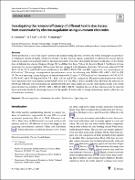| dc.identifier.citation | Omwene, P. I., Can, O. T., Öz, U. M., Keyikoğlu, R. (2023). Investigating the removal efficiency of different textile dye classes from wastewater by electrocoagulation using aluminum electrodes. International Journal of Environmental Science and Technology, 20(2). https://doi.org/10.1007/s13762-023-04841-9 | en_US |
| dc.description.abstract | Textile production is one of the largest sectors in the manufacturing industry; however, the textile dyeing process produces a voluminous amount of highly colored wastewater. The dyes used are organic compounds of different dye classes that are stable in an aquatic environment with low decomposition rates. This study investigated the removal efficiency of five textile dyes of different dye classes (Disperse Orange 30, Acid Blue 324, Basic Yellow 28, Reactive Black 5, Vat Brown 1) from wastewater by electrocoagulation (EC) process that was equipped with aluminum electrodes. EC process achieved 91.98, 98.13, 47.46, 92.55, and 82.60% removal efficiencies for AB324, BY28, VBI, and RB5, respectively, at a current density of 0.83 mA/cm2. The energy consumption for dyestuff removal was in the following order: DO30 < VB1 < RB5 < AB324 < BY28. The total operating cost per kilogram of dyestuff removed in 15 min at 0.0502 mA/cm2 was determined as 0.250, 0.274, 0.550, 0.647, and 0.764 $/kg for DO30, VB1, RB5, AB324, and BY28, respectively. The removal mechanism was well fitted to the pseudo-first-order kinetic model with R2 above 0.94 for AB324, BY28, and RB5 dyes. However, the removals for DO30 and VBI dyes were exponential and neither fitted the first-order kinetic nor second-order kinetic model. The overall removal trend was as follows: DO30 > VB1 > AB324 > RB5 > BY28. Therefore, the use of dyes that can easily be removed from wastewater should be encouraged to preserve the quality of water in the receiving environments and to reduce the cost of wastewater treatment. | en_US |

